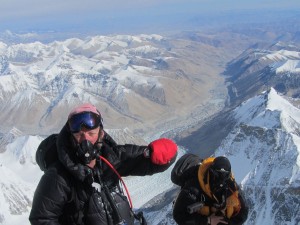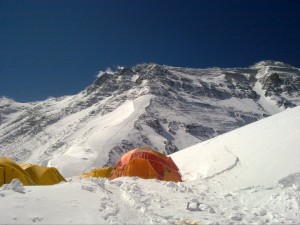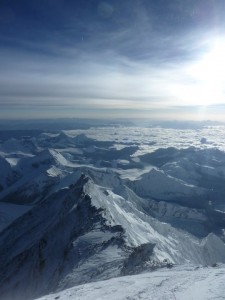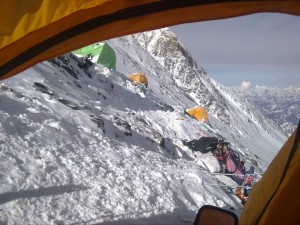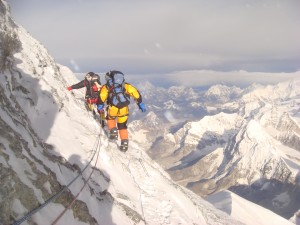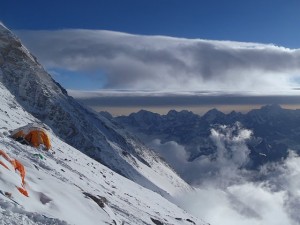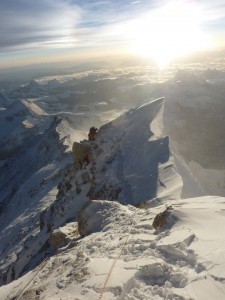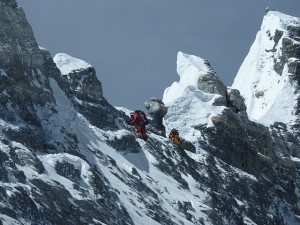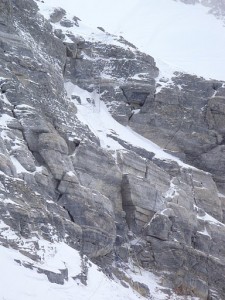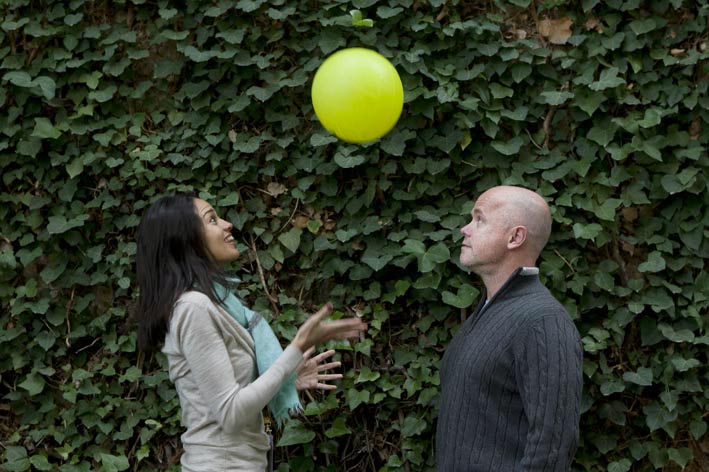I think everyone within exploration and adventure have, or still is, nurturing the dream to climb the highest mountain on earth – Mount Everest. It is one of the legends. The dream for so many. I still hope one day I will make the attempt. It has been there for years, but other things have taken over to dominate my life. But it is still there. I have on and off wondered, how is it really, to climb Mount Everest today? When so many things have changed and the peak is so much more accessible than it ever has been. So I asked Ben Thackwray, who just did this extra ordinary climb, to tell us all!
Why ‘I’ climbed Mount Everest, and maybe why you shouldn’t
by
Ben Thackwray
This is an abridged extract from a chapter of the book I’m writing that also includes the stories of how ‘a whale’ smashed our rudder off our ocean rowing boat in the middle of the Atlantic and how we were hunted by two Polar Bears for two days in Greenland:
I’m not going to lie to you; I’m not the first person to climb Mount Everest!
For me climbing Everest wasn’t about doing something that would grab the headlines and it wasn’t about doing something completely contrived or exaggerated to seem more interesting or grandiose than it actually is.
I wasn’t going to ‘do it for charity’ (I worked hard and saved up for it for ten years and still had to borrow a large amount from the bank as I didn’t pursue any sponsorship), and I wasn’t going to do it on a pogo stick or be ‘the first person to carry a bottle of Reggae Reggae sauce to the summit’. (And now I’ve done it I’m not going to claim some stupidly specific title like ‘first man to row the Atlantic, ski across Greenland, run the Marathon des Sables, traverse Denali, climb Mount Everest, be 5’ 8” and live in Leeds’, because I don’t know, or care if I am or not’!)
I climbed Mount Everest purely for the love and experience of doing it.
Climbing Mount Everest has simply always been something that I have wanted to do ever since I can remember, but I remember specifically when I committed to it. It was the 13th of May 1995 (my 15th birthday) and there was a piece on ‘Newsround’ about Alison Hargreaves reaching the summit of Mount Everest. I remember standing there watching it, knowing, that I was going to do that one day (and secretly hoping to summit on my 30th birthday).
Climbing Mount Everest was actually part of a long list of things which formed naturally through childhood that I ‘knew’ I was going to do and which I’m working my way through. The big three (which are public knowledge) of the longer list were to Row the Atlantic, climb Mount Everest and Ski to the South Pole, which I grouped together into a personal project which goes by the name of ‘The Adventure Trilogy’. The idea with the Trilogy was that I would have to, ‘to some extent’, master three very different disciplines in three very different dangerous environments and I would get to experience firsthand everything that goes with that. It’s never been about doing ‘something’ out of the ordinary for me, it’s always for me been about certain specific things and I’m pretty sure once the list is finished I give it all up and go and live in a log cabin somewhere away from everything. I think if you don’t inherently already know what the majority of your next c10 projects are going to be, and you’re searching around to create ‘something’ to do, maybe whatever you end up doing perhaps doesn’t mean that much to you and maybe, you’re just doing it for a different reason? – Which is fine, I understand that, and each to their own.
Having rowed the Atlantic in 2008 I had planned to go to Everest in 2010 but due to a set back out in Greenland in 2009 on an expedition we were using as a precursor to our South Pole attempt (The ENDURE MORE expedition), Everest had to be put back to 2011. When I finally got to base camp this year in Tibet it was everything I had imagined and planned for, for all those years.
Sitting back at home now feeling fine I could find it easy to say it was a piece of cake but I have to admit it was a lot more difficult than I was expecting! It is difficult, anyone who thinks because it’s a popular mountain these days that it is easy, is an idiot. (And as you can probably tell I’m pretty tired of hearing things like ‘more people have climbed Everest than….rode a bike along this obscure coastal track whilst wearing a tutu’, or something to that effect).
I climbed Everest via the North East Ridge which is the route made famous by Mallory and Irvine’s 1924 ill fated attempt. For me because of the history and the actual climbing en route to the summit this offered the most interesting climbing option as opposed the southern route first climbed by Norgay and Hillary in 1953. (Who along with Mallory and Irvine, having been there now myself, my already gushing admiration for has grown significantly).
Above the mass of crevasses, over hanging seracs, avalanche hazards and ice walls that is the North Col and the deceptively steep (and seemingly never ending) snow slope of the North Ridge, the climbing really gets interesting! But I can’t really tell you anything about the route that you can’t find in a book somewhere else, other than maybe; there is “a big rock” at c7200m!
What I can tell you is that my summit day and the events that unfolded I’ll never forget and may have changed my life a little.
Summit day really starts from camp 2 at 7800m as you spend so little time at camp 3 at 8300m (the highest campsite in the world) before the final push for the summit. When we started out from 8300m in the dark at around 21:00, it was cold but not too cold (about -20 centigrade) it was snowing a little but there was hardly any wind. Even though I was already tired, being well above my previous altitude record I started strong, but it wasn’t long before things started to go ‘downhill’.
There are around 12 dead bodies of climbers on this route above 8300m, one wrapped in a tent just a few yards from where we started in camp 3 but mostly they’re up high on the ridge above 8500m. After a few hours we made it up onto the North East Ridge itself and ‘took a right’ just before the famous ‘landmark’ of the body of an Indian climber, Tsewang Paljor, now referred to as ‘Green Boots’. I’m not going to sugar coat this, the route is so narrow at this point you have to pass within 2 feet of his body, and although I’m not squeamish or affected by things like this it is a very real reminder that you are pushing the limits and should things go wrong in the next 12 hours this is where you’ll stay!
After passing Green Boots, on the ridge there are just the three famous rock ‘steps’ to negotiate and over a mile in length of highly exposed ridge. “What could be simpler, there are fixed ropes and ladders, it’s just a walk” – I have to say that this view which I’ve heard a few times is not only flippant and uniformed it’s a little bit stupid!
The three steps each produced events that I will never forget. It was still night as I made it to the first step and below us, a long way below us, we could see the flashing and cracking of thunderstorms in the clouds over in the distance towards Cho Oyu.
I committed to climbing the first step in my smaller gloves as it appeared a lot more difficult than expected and as it wasn’t particularly cold I’d benefit from the added dexterity. Unfortunately climbing the first step took longer than expected and my hands got extremely cold due to a combination of a number of contributing factors, and because of where I was, hanging off the mountain over a substantial fall I couldn’t stop to either warm my hands properly or get my biggest mitts out. I was a little bit unlucky, and by the time I reached the top of the step and a place where I could stand and stop, my hands were frozen! When I removed my gloves to assess the damage I could see my right hand in particular had no blood in any of the fingers past their base at the palm of my hand, I had frostbite!
I now had the difficult decision to make, do I go back down and try and save my fingers, or do I carry on to the summit and risk losing them all?! After warming my hands the best I could, stood there on a knife edge ridge over 8500m in the dark, I managed to get blood back almost right to ends of my fingers, and as I was alone at the top of the step I simply radioed into Advanced Base Camp, “Just climbed the first step, moving on toward the second’. I decided to carry on toward the summit.
Although the summit was still around 7 hours away at this point and the decision resulted in me losing the distal phalanx of two fingers when I got back home (which I’ve had made into a very nice, albeit macabre, pair of cufflinks) I don’t regret it one bit, because to me, it was worth it! (Anyone that says climbing Everest isn’t worth losing the ends of a few fingers for maybe isn’t as passionate about climbing it as I was, or maybe to them it isn’t worth it, which I understand. To me it was. I certainly wouldn’t advise making the same decision as I did to someone else though, I’d tell them to go down immediately, as would the guys I was climbing with, absolutely, which is why I kept it to myself!)
So with a frozen hand I moved along the ridge towards the second step, famously the crux of the route. Because it is the crux, it is a lot more discussed than the other two steps so before you get there, you will have seen pictures of it and discussed it in more detail, and generally will be well prepared for it. What I wasn’t prepared for was what happened whilst I was climbing it.
The oxygen masks we were using which are the best performers at high altitude have a rubber valve on the right hand side to allow ambient air flow into the mask to mix with the flow of oxygen from the oxygen system itself. The valve itself is covered by a small piece of plastic which keeps your down jacket from obstructing the valve. When I was climbing the second step I noticed that this plastic cap had fallen off, and the reason I noticed it was missing was because the rubber valve which it covers was now completely frozen and not allowing any air into the mask at all. I was gasping and again found myself in a position not conducive to sorting problems like this out.
Then, when not only was I climbing the most strenuous section of the route, with a frozen hand, and a broken oxygen system in the dark at c8700m, all of a sudden my guts woke up for the day! I’d had the shits for the last few days and at this point with everything else going on I wasn’t going to be able to stop here, loosen all my down clothing and under garments and relieve myself (at least, outside my clothing). So I literally, and quiet happily at the time, shit myself!
At the top of the second step I managed to unfreeze the oxygen masks valve by removing the mask completely and breathing as hard as I could onto the valve to defrost it. This was only a temporary fix though and every 20 minutes or so from then on I had to stop as the mask collapsed against my face as it repeatedly froze , inevitably when I needed air the most, and try again and again to defrost it. This was a less than ideal situation to be in above 8700m at the top of second step where there is an obvious scattering of dead bodies, most of whom I believe were attempting to summit without oxygen, and again I had to assess this time whether my now less than perfect oxygen supply was reason to continue or to retreat. This will sound bad but, I never had any doubt that I was going to reach the summit so even though things were going far from ‘the plan’ this was just another thing at the time to accept and deal with, and I carried on.
Shortly after this the sun came up and we could see the curvature of the earth and how beautiful everything was so far beneath us, although this was only appreciated in hindsight looking back at photos taken, because at the time, as everyone is at this point, I was pretty much on my last legs and really pushing myself to the limit and it was intense focus, at least for me, that seemed to mask any sentimentality or appreciation for the beauty of where I was.
By the time you get to the third step it feels pretty close to the summit and I climbed this with relative ease only to discover that above this, on a very exposed knife edge section where there’s an enormous serac over hanging the 13,000ft, almost vertical, drop of the Kanshung face; there was no pre-fixed rope and the section needed to be traversed free (and very carefully). It wasn’t until on the descent that it became apparent there was actually a rope, but it was pulled off the ridge down the north face by the body attached to it of an Irish climber we had met alive and well just a few days before down in Base Camp.
So after another hour or so, and a very exposed final traverse of the highest part the North Face at c8800m I finally made it to the summit ridge and set foot on the summit of Mount Everest on the 26th May 2011, 16 years after I committed myself to it.
Exhausted, with a frozen hand, massively hypoxic due to problems with my oxygen mask (and not forgetting the altitude!), sat covered in my own piss and shit having had to literally climb over the dead bodies of people we knew to get there, I didn’t exactly feel particularly triumphant as you might have expected one would do, being able to look down on the rest of the world; and having never had any doubt I would get there I didn’t feel the need to savour the moment or celebrate too much so I only spent a few minutes there before I set off down to ensure that I got down alive and we could call the climb ‘a success’. (Watch video from the summit here)
The descent, as expected, was infinitely harder than the ascent and I was ‘in the hurt locker’ like I’d only been once or twice before, once at the end of a 100 mile nonstop ultra marathon over the Pennines and when we crossed Greenland in 2010 in 15 days, but I do think it was these types of experiences that got me down, because I ‘knew’ I could keep going!
I was completely alone when I descended the hardest part of second step safely and just as I was feeling that I could make it down in one piece my crampon slipped on some loose snow and I took a fall off the edge of the step over the north face and landed flat on my back on a very small ledge about 5-6 feet below where I should have been and about 1 foot higher than where the rope would have broken my fall completely – the drop beyond the ledge was only about 8000ft. I wasn’t hurt but laying there on my back I looked up over my shoulder to see what I think was the body of another climber who I believe had done a similar thing on descent but broken a leg and consequently had not been able to move any further.
It was time to stop messing around at this point and I pushed hard to get down and made it back to high camp a few hours later where I stayed for just a few hours more before setting off again to get below 8000m to camp 2 at 7800m. Camp 2 was a welcome sight but after being on the go for around 20 hours, reaching the summit, getting back down, being covered in my own piss and shit, hypoxic, with a frostbitten hand, I was incredulous to find two European climbers inside my tent on their way up the mountain with no kit of their own! One was even inside my sleeping bag refusing to get out because, I quote, “my hands are cold”!
Thankfully the other guy wasn’t an arse hole, and after 20 minutes of what I’ll describe as ‘polite discussion’ (officially no swearing or threatening each other involved at all), we agreed I was right! (To quote Brian Clough), and he removed himself from my tent and I slipped into my nice ‘pre-warmed’ sleeping bag and went soundly to sleep.
Ben´s CV:
- Climbed Kilimanjaro in 2 days no acclimatisation
- Finished top 10 Brits in the Marathon des Sables
- Ultra marathon runner, max distance 100 miles non-stop and PB for 50 miles of 7hrs 57mins
- Summited and traversed Denali (Mount McKinley) – 1 of the only times in last ten years
- Rowed across the Atlantic – Set the fastest ever crossing from Canaries to Antigua
- Set fastest British crossing of Greenland
- Climbed Everest
He also works as an expedition leader and manager and professional adventurer for Adventure Hub (www.adventurehub.com) and am currently recruiting crews and team members for an Indian Ocean rowing record, the Adventure Hub expedition series and planning for our Antarctic Traverse expedition next year.


